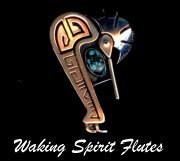Playing Your Flute |
Sharing My Gift - by Waking Spirit |
The 6 Hole Pentatonic Native American Flute |
|||||||||||||||||||||||||||||||||||||||||||||||||||||||||||||||||||||||||||||||||||||||||||||||||||||||||||||||||||||||||||||||||||
Note to all Flute Makers, Tutors and Students of Native American (Style) Flutes: It is a genuine and paramount mission in my lifetime to help progress, educate and preserve the continuance of the Native American inspired Flute. In keeping with this I freely offer (and at no cost) any of the flute image files on this page to anyone who wishes to use them. If you are a Tutor and wish to copy the flute images set out on this page for duplication onto tablature sheets, please feel free to do this. Should you use any of the images for the development of web pages pertaining to a mission in keeping with mine, again, please feel free to do this. All I ask in return is that credit for the images be given to Waking Spirit Flutes and that you copy and paste (or download) the images onto your own computer and not link them directly to this web site. Waking Spirit - Being true to himself and his mission by continuing to share 'The Gift'. . . Welcome to the wonderful world of playing the Native American inspired Flute! The instructions and information contained in this page have been written to help you on your journey and quest for knowledge and I hope you find the contents both informative and useful. Whereas these instructions will help you commence your journey into playing your flute, they are by no means complete. Further study will be necessary and I have recommended additional reading and literature at the foot of this page. The first thing you need to do is to understand how your Native American Flute works. This will help you set up your flute for maximum playing ability and tone. When you first receive your flute it is more than likely that the BIRD (or Block) may have been moved from its original position and this needs to be checked and rectified before commencing to play your flute. This can be done very quickly and simply! First, make sure the block is sitting squarely on the bridge and that the front edge of the block is close to the edge of the sound hole without covering any part of it. Also, make sure the leather thonging that holds the block onto the flute is tight. Cover all the FINGER HOLES with the first three fingers of both hands with the fleshy part of your fingers - the fleshy part being the soft cushion area between the end of your finger and the first joint. Next, place the BLOW HOLE end of the flute to your lips taking care NOT to insert the end of the flute into your mouth but merely place the flute gently upon your bottom lip and allow your top lip to surround the blow hole to a gentle seal. |
|||||||||||||||||||||||||||||||||||||||||||||||||||||||||||||||||||||||||||||||||||||||||||||||||||||||||||||||||||||||||||||||||||
 |
|||||||||||||||||||||||||||||||||||||||||||||||||||||||||||||||||||||||||||||||||||||||||||||||||||||||||||||||||||||||||||||||||||
With all the finger holes covered, blow gently into your flute. If the note you hear is crisp, clear and steady, begin lifting your fingers off the finger holes starting from the lowest hole - the hole farthest away from the bridge. Continue to do this for every note checking to hear that each note is clear and crisp. If any notes are not playing correctly, adjust the Bird by sliding it back towards the blow hole. The adjustment necessary will be very slight so be very careful when you do this! An adjustment of just one sixty-fourth of an inch can make all the difference to the playing ability of your flute. Once you have the flute set you are ready to begin playing it. There are several techniques that you will need to learn in order to play your flute effectively (breath control, finger control, note bending, tonguing, slurring, double tonguing and vibrato) but, for now, we will just concentrate on making your flute play some basic notes using two simple techniques. The first is the simple technique of blowing a gentle and constant stream of air into your flute. |
|||||||||||||||||||||||||||||||||||||||||||||||||||||||||||||||||||||||||||||||||||||||||||||||||||||||||||||||||||||||||||||||||||
Practice this for a few moments or until you feel comfortable that you have mastered this technique. The second technique is called 'tonguing' and is achieved by blowing into your flute with a soft 'dooo' sound. |
|||||||||||||||||||||||||||||||||||||||||||||||||||||||||||||||||||||||||||||||||||||||||||||||||||||||||||||||||||||||||||||||||||
Again, practice this technique for a few moments or until you feel comfortable that you have mastered it.
Now let's learn some scales:
Here are some more scales for you to learn and practice your fingering with:
|
|||||||||||||||||||||||||||||||||||||||||||||||||||||||||||||||||||||||||||||||||||||||||||||||||||||||||||||||||||||||||||||||||||




